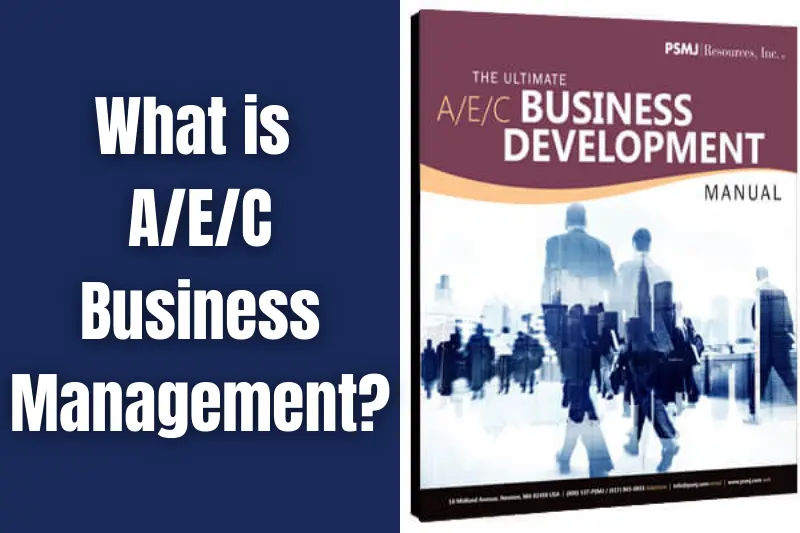In the fast-paced world of construction, architecture, and engineering, managing a business effectively can be a challenge. That’s where A/E/C Business Management comes in. This field focuses on the strategies, tools, and skills needed to successfully run projects in the Architecture, Engineering, and Construction (A/E/C) industry.
Effective A/E/C Business Management helps companies stay organized, meet deadlines, and keep costs under control. In this article, we’ll explore what A/E/C business management is, why it’s important, and how you can improve it in your organization.
What is A/E/C Business Management?
A/E/C business management refers to the strategies and practices used to run a successful business in the architecture, engineering, and construction (A/E/C) industries. It involves overseeing projects, managing finances, and ensuring team coordination to achieve company goals. Effective management in this field is essential for delivering projects on time, within budget, and to the required quality standards.

Core Aspects of A/E/C Business Management
Project Management
- Managing the timeline, scope, and resources for projects.
- Ensuring that each project is delivered on time and within budget.
- Tracking milestones and making adjustments when needed.
- Ensuring all stakeholders are aligned and informed throughout the project.
Finances
- Budgeting and cost management are critical for profitability.
- Keeping track of project expenses and ensuring there are no cost overruns.
- Securing funding and managing cash flow to keep projects running smoothly.
- Making financial decisions that balance risk and reward for long-term business health.
Team Coordination
- Ensuring effective communication among team members, contractors, and clients.
- Aligning different disciplines (e.g., architects, engineers, contractors) to work toward a common goal.
- Building a collaborative environment that fosters productivity and creativity.
- Managing conflict and resolving issues promptly to maintain project flow.
Why A/E/C Business Management is Critical for Success
- Without effective business management, A/E/C companies risk missing deadlines, going over budget, or losing quality.
- It ensures that resources are used efficiently, reducing waste and increasing profitability.
- Strong business management builds trust with clients, which leads to repeat business and new opportunities.
- It helps navigate the complexities of the A/E/C industry, ensuring compliance with regulations and industry standards.
You may also like it:
Personal Finance Guide: Tips for Financial Success
Smart Home Trends: Top Innovations for 2025
Easy Budgeting Tips: Manage Your Money Smartly
Key Challenges in A/E/C Business Management
Managing A/E/C businesses comes with a unique set of challenges. Let’s take a look at some of the key hurdles:
Complexities of Multi-Disciplinary Teams
- Teams in the A/E/C industry often include architects, engineers, contractors, and other specialists.
- Coordinating these different professionals with varying expertise can be tricky.
- Misunderstandings or lack of alignment can lead to project delays or mistakes.
- Clear communication and defined roles are essential to avoid confusion.
Managing Timelines and Budgets
- A/E/C projects are often large and complex, with tight deadlines and strict budgets.
- Delays can lead to increased costs and dissatisfied clients.
- Staying on track requires constant monitoring of both time and expenses.
- Effective project scheduling and financial oversight are key to avoiding overruns.
Regulatory and Compliance Issues
- A/E/C businesses must comply with local, state, and federal regulations.
- This includes safety codes, zoning laws, and environmental requirements.
- Failing to meet these standards can result in costly fines or project stoppages.
- Keeping up with constantly changing laws is crucial for smooth operations.
Coordination Between Various Stakeholders
- A/E/C projects involve multiple stakeholders, including clients, contractors, architects, and suppliers.
- Each party has different goals, priorities, and expectations, which can lead to conflicts.
- Effective communication and regular updates are essential to keep everyone on the same page.
- Misalignment can cause delays, quality issues, or budget overruns.
Best Practices in A/E/C Business Management
Implementing the right practices can make a huge difference in the success of A/E/C projects. Here are some of the best practices that can help streamline operations:
Streamlining Communication Across Teams
- Clear communication ensures that all team members are on the same page.
- Regular updates help prevent misunderstandings or mistakes.
- Use of collaboration tools (e.g., Slack, Microsoft Teams) enhances real-time communication.
- Setting clear expectations and responsibilities helps avoid confusion.
Effective Project Planning and Scheduling
- Develop a detailed project plan that outlines all phases and deadlines.
- Use project management software (like Procore) to track progress and adjust schedules.
- Prioritize tasks to ensure that critical milestones are achieved on time.
- Regularly review and update schedules to accommodate any changes or delays.
Financial Management and Cost Control
- Set a realistic budget from the beginning and track all project expenses closely.
- Use financial software to monitor cash flow and identify potential cost overruns.
- Control costs by managing procurement efficiently and avoiding unnecessary expenses.
- Regular financial reports help keep the project on budget and allow for early intervention.
Risk Management Strategies
- Identify potential risks early, such as regulatory changes or supplier delays.
- Develop contingency plans to minimize the impact of unexpected events.
- Keep track of risk factors and regularly assess their impact on the project.
- Train the team on how to handle risks and adjust plans when needed.
Implementing Technology Solutions (e.g., Project Management Software)
- Project management tools help in tracking timelines, budgets, and communication.
- These tools can also improve collaboration between teams and reduce errors.
- Software like Procore or Buildertrend can streamline document sharing and approvals.
- Technology improves data analysis, which helps in making informed decisions.
How to Improve A/E/C Business Management
Improving A/E/C business management requires taking proactive steps. Here are some key ways to enhance your business operations:

Steps to Enhance Operational Efficiency
- Streamline processes to reduce unnecessary steps or delays.
- Implement automation tools to speed up routine tasks (e.g., invoicing, scheduling).
- Regularly review workflows and eliminate bottlenecks to keep the project on track.
- Encourage cross-functional collaboration to improve overall efficiency.
Training and Development of Project Managers
- Invest in regular training to improve project management skills.
- Focus on leadership, communication, and problem-solving skills for better team handling.
- Offer certifications (e.g., PMP) to improve professional credibility and project outcomes.
- Encourage mentorship and peer learning to build a knowledgeable management team.
Building a Culture of Collaboration
- Foster an open environment where team members feel comfortable sharing ideas.
- Promote regular team meetings to align everyone’s goals and expectations.
- Encourage respect for diverse skills and expertise within the team.
- Use collaborative tools to improve coordination and make teamwork more efficient.
Using Data and Analytics for Better Decision-Making
- Collect data on project performance to identify trends and areas for improvement.
- Use analytics to forecast potential issues (e.g., delays, cost overruns) before they happen.
- Leverage project management software to track real-time progress and make adjustments as needed.
- Make data-driven decisions to optimize resources and improve project outcomes.
Tools and Software for A/E/C Business Management
Using the right tools can drastically improve the efficiency and success of A/E/C projects. Here are some popular tools that are widely used in the industry:
Procore
- Procore is a comprehensive construction management software designed to streamline project workflows.
- It integrates various functions such as budgeting, scheduling, and document management in one platform.
- Procore’s real-time updates help teams stay aligned and avoid miscommunication.
- It allows for easy collaboration with clients, subcontractors, and vendors, ensuring smooth project execution.
Buildertrend
- Buildertrend is a cloud-based project management tool tailored for construction businesses.
- It offers features like project scheduling, budget tracking, and communication tools for teams and clients.
- Buildertrend’s user-friendly interface makes it easy to track project progress and address issues quickly.
- It also includes tools for document sharing, invoice tracking, and customer feedback, which help improve client satisfaction.
PlanGrid
- PlanGrid is a digital blueprint and construction management tool that helps teams access real-time project plans.
- It allows users to view, mark up, and share construction drawings directly from mobile devices, improving accuracy.
- PlanGrid improves collaboration by allowing all stakeholders to view the same set of up-to-date drawings and documents.
- It simplifies the process of tracking project issues and managing field reports, which saves time and reduces errors.
How These Tools Improve Workflow, Project Tracking, and Reporting
- Streamline Communication: These tools centralize project details, making communication easier between team members, contractors, and clients.
- Improve Project Tracking: Real-time updates help teams track progress, identify delays, and address issues quickly.
- Enhance Reporting: Automated reports allow managers to easily monitor project health and financial status, ensuring that everything stays on track.
- Boost Efficiency: By automating tasks like scheduling and documentation, these tools save time and reduce manual errors.
Real-Life Examples of Successful A/E/C Business Management
Looking at real-life examples of companies that excel in A/E/C Business Management can offer valuable insights. Here are some case studies of companies that have successfully managed their projects and businesses:
Case Study: Turner Construction
- Turner Construction is a leading construction firm that has successfully managed large-scale projects worldwide.
- They focus on clear communication and collaboration, ensuring all stakeholders are on the same page.
- Turner uses Procore for project management, allowing them to track budgets, schedules, and team performance in real time.
- Their approach to risk management includes careful project planning and anticipating potential delays, helping them deliver projects on time and within budget.
Lessons Learned:
- Invest in project management software to improve efficiency.
- Build a culture of collaboration across teams and stakeholders.
- Always plan for risks and have contingency plans in place.
Case Study: Skanska
- Skanska, a global construction and development company, has a reputation for managing complex projects effectively.
- They integrate sustainability and technology into their project management processes, ensuring both environmental and financial goals are met.
- Skanska uses BIM (Building Information Modeling) for enhanced planning and execution, which improves efficiency and reduces errors on site.
- They have a strong focus on safety, with proactive measures to prevent accidents and maintain compliance with regulations.
Lessons Learned:
- Use advanced technology (like BIM) to streamline operations and improve accuracy.
- Focus on safety and compliance to avoid costly disruptions.
- Incorporate sustainability into business management to improve long-term success.
Case Study: Bechtel
- Bechtel is one of the largest engineering, construction, and project management companies globally.
- They manage large infrastructure projects by focusing on solid project planning, risk management, and innovative solutions.
- Bechtel uses specialized software to monitor project performance, enabling quick adjustments if needed.
- Their teams are highly skilled and trained to adapt to complex challenges and deliver high-quality results.
Lessons Learned:
- Focus on thorough project planning and risk management to mitigate challenges.
- Use specialized tools to track and measure project performance.
- Invest in skilled project managers and ongoing training to handle complex projects.
Strategies That Worked for These Companies:
- Adopting Technology: All three companies leverage advanced technology, such as project management software, BIM, and cloud-based tools, to improve efficiency.
- Clear Communication: Regular updates, transparent processes, and collaborative platforms ensure all team members and stakeholders stay aligned.
- Risk Management: Proactively identifying risks and having contingency plans helped them avoid common project pitfalls.
- Skilled Team Management: Ensuring that project managers and teams have the right skills and training to handle complex tasks.
Conclusion
Effective A/E/C Business Management is crucial for the success of projects in the architecture, engineering, and construction industries. By adopting the right tools, improving communication, and focusing on clear planning, companies can overcome challenges and deliver projects on time and within budget.
Learning from real-world examples, such as Turner Construction, Skanska, and Bechtel, shows that investing in technology, risk management, and skilled teams can lead to long-term success. Keep these best practices in mind, and you’ll be well on your way to running a successful A/E/C business.
Common FAQs About A/E/C Business Management
What is A/E/C Business Management?
A/E/C Business Management refers to managing projects and operations in the Architecture, Engineering, and Construction industries. It involves tasks like project planning, budget management, team coordination, and ensuring quality and safety.
Why is A/E/C Business Management important?
It helps ensure that projects are completed on time, within budget, and to the required quality standards. Good management reduces risks, improves communication, and leads to greater client satisfaction.
What challenges do A/E/C businesses face?
Common challenges include managing multi-disciplinary teams, keeping projects on schedule and within budget, handling regulatory compliance, and coordinating between different stakeholders like clients and contractors.
How can I improve my A/E/C business management?
To improve, focus on clear communication, invest in project management tools, train your project managers regularly, and adopt risk management strategies. Building a culture of collaboration also helps.
What tools can help with A/E/C Business Management?
Popular tools include Procore, Buildertrend, and PlanGrid. These help with project tracking, budget management, team collaboration, and real-time updates, making it easier to stay organized and efficient.
How do I manage project budgets effectively?
Track every expense carefully using financial tools, set realistic budgets from the start, and monitor costs regularly to prevent overruns. Always have a contingency plan for unexpected costs.
How can I streamline communication among my teams?
Use communication platforms like Slack or Microsoft Teams to keep everyone updated. Schedule regular check-ins and make sure all team members and stakeholders are aligned on goals and expectations.
Bonus Points
- Clear Communication Is Key: Always ensure that every team member and stakeholder is on the same page to avoid costly misunderstandings.
- Use Project Management Software: Tools like Procore and Buildertrend help keep track of schedules, budgets, and project updates in real-time.
- Plan for Risks: Anticipate potential challenges and create contingency plans to address them before they become issues.
- Invest in Team Training: Skilled project managers and team members are essential for successful project delivery—regular training can make a huge difference.
- Monitor Budgets Closely: Keep an eye on expenses to avoid overruns. Use financial tools to track costs and adjust plans as needed.
- Collaborate Across Disciplines: Architecture, engineering, and construction teams must work together seamlessly. Foster a culture of teamwork.
- Leverage Technology: Implement BIM (Building Information Modeling) or similar technologies to enhance planning, execution, and accuracy.
- Be Flexible with Scheduling: Unexpected changes happen, so be prepared to adapt timelines to keep the project moving forward.
- Focus on Quality Control: Ensure that every project phase meets high standards, reducing rework and increasing client satisfaction.
- Sustainability Matters: Incorporating sustainable practices not only benefits the environment but also improves your company’s reputation and reduces costs over time.
You may also like it:
Saving Money Tips for Students: Master Your Finances Now!
Startup Marketing Strategies: Boost Your Business Fast
Startup Funding Sources: Top Options for Your Business
Aajkitajikhabar.com Business: Insights and Growth | TeckJB com







